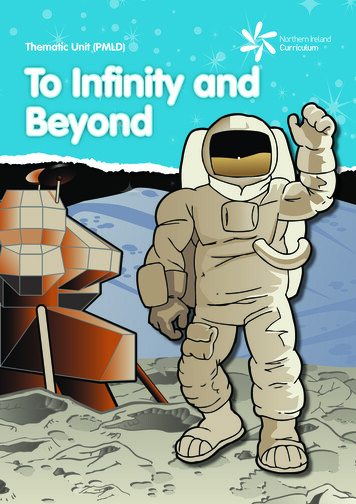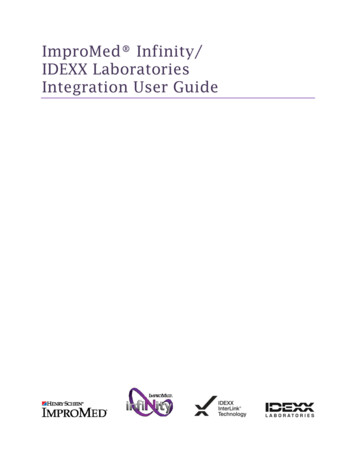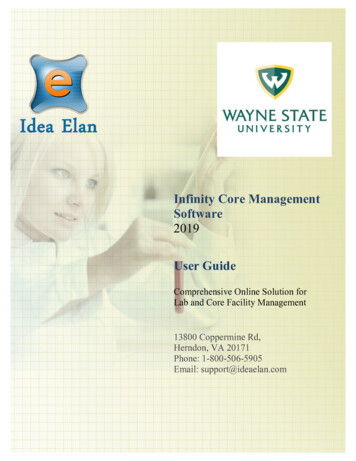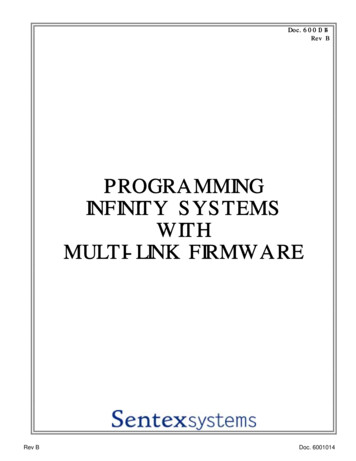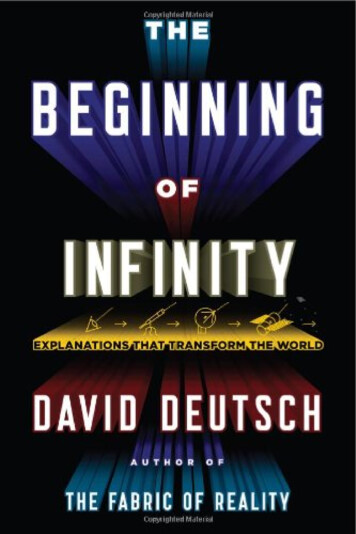
Transcription
david d e ut schThe Beginning of InfinityExplanations that Transform the WorldVIKING
The Beginning of Infinity
david d e ut schThe Beginning of InfinityExplanations that Transform the WorldVIKING
VIKINGPublished by the Penguin GroupPenguin Group (USA) Inc., 375 Hudson Street,New York, New York 10014, U.S.A.Penguin Group (Canada), 90 Eglinton Avenue East, Suite 700,Toronto, Ontario, Canada M4P 2Y3(a division of Pearson Penguin Canada Inc.)Penguin Books Ltd, 80 Strand, London WC2R 0RL, EnglandPenguin Ireland, 25 St. Stephen’s Green, Dublin 2, Ireland(a division of Penguin Books Ltd)Penguin Books Australia Ltd, 250 Camberwell Road, Camberwell,Victoria 3124, Australia(a division of Pearson Australia Group Pty Ltd)Penguin Books India Pvt Ltd, 11 Community Centre, Panchsheel Park,New Delhi – 110 017, IndiaPenguin Group (NZ), 67 Apollo Drive, Rosedale, Auckland 0632,New Zealand (a division of Pearson New Zealand Ltd)Penguin Books (South Africa) (Pty) Ltd, 24 Sturdee Avenue,Rosebank, Johannesburg 2196, South AfricaPenguin Books Ltd, Registered Offices:80 Strand, London WC2R 0RL, EnglandPublished in 2011 by Viking Penguin,a member of Penguin Group (USA) Inc.Copyright David Deutsch, 2011All rights reservedExcerpts from The World of Parmenides by Karl Popper, edited by Arne F. Petersen (Routledge, 1998). Used bypermission of the University of Klagenfurt, Karl Popper Library.Illustration on page 34: Starfield image from the Digitized Sky Survey ( AURA) courtesy of the Palomar Observatoryand Digitized Sky Survey, created by the Space Telescope Science Institute, operated by AURA, Inc. for NASA.Reproduced with permission of AURA/STScI.Illustration on page 426: Bettmann/CorbisLIBRARY OF CONGRESS CATALOGING IN PUBLICATION DATADeutsch, David.The beginning of infinity : explanations that transform the world / David Deutsch.p. cm.Includes bibliographical references and index.ISBN: 978-1-101-54944-51. Explanation. 2. Infinite. 3. Science—Philosophy. I. Title.Q175.32.E97D48 2011501—dc222011004120Without limiting the rights under copyright reserved above, no part of this publication may be reproduced, stored in orintroduced into a retrieval system, or transmitted, in any form or by any means (electronic, mechanical, photocopying,recording or otherwise), without the prior written permission of both the copyright owner and the above publisher ofthis book.The scanning, uploading, and distribution of this book via the Internet or via any other means without the permission ofthe publisher is illegal and punishable by law. Please purchase only authorized electronic editions and do not participate inor encourage electronic piracy of copyrightable materials. Your support of the author’s rights is appreciated.
8.9.10.11.12.13.14.15.16.17.18.viviiThe Reach of ExplanationsCloser to RealityThe SparkCreationThe Reality of AbstractionsThe Jump to UniversalityArtificial CreativityA Window on InfinityOptimismA Dream of SocratesThe MultiverseA Physicist’s History of Bad PhilosophyChoicesWhy are Flowers Beautiful?The Evolution of CultureThe Evolution of CreativityUnsustainableThe 98418443BibliographyIndex460463
AcknowledgementsI am grateful to my friends and colleagues Sarah Fitz-Claridge, AlanForrester, Herbert Freudenheim, David Johnson-Davies, Paul Tappenden and especially Elliot Temple and my copy-editor, Bob Davenport,for reading earlier drafts of this book and suggesting many correctionsand improvements, and also to those who have read and helpfullycommented on parts of it, namely Omri Ceren, Artur Ekert, MichaelGolding, Alan Grafen, Ruti Regan, Simon Saunders and Lulie Tanett.I also want to thank the illustrators Nick Lockwood, Tommy Robinand Lulie Tanett for translating explanations into images moreaccurately than I could have hoped for.vi
IntroductionProgress that is both rapid enough to be noticed and stable enough tocontinue over many generations has been achieved only once in thehistory of our species. It began at approximately the time of thescientific revolution, and is still under way. It has included improvements not only in scientific understanding, but also in technology,political institutions, moral values, art, and every aspect of humanwelfare.Whenever there has been progress, there have been influentialthinkers who denied that it was genuine, that it was desirable, or eventhat the concept was meaningful. They should have known better. Thereis indeed an objective difference between a false explanation and atrue one, between chronic failure to solve a problem and solving it,and also between wrong and right, ugly and beautiful, sufferingand its alleviation – and thus between stagnation and progress in thefullest sense.In this book I argue that all progress, both theoretical and practical,has resulted from a single human activity: the quest for what I callgood explanations. Though this quest is uniquely human, its effectiveness is also a fundamental fact about reality at the most impersonal,cosmic level – namely that it conforms to universal laws of nature thatare indeed good explanations. This simple relationship between thecosmic and the human is a hint of a central role of people in the cosmicscheme of things.Must progress come to an end – either in catastrophe or in somesort of completion – or is it unbounded? The answer is the latter. Thatunboundedness is the ‘infinity’ referred to in the title of this book.Explaining it, and the conditions under which progress can and cannotvii
intro ductio nhappen, entails a journey through virtually every fundamental field ofscience and philosophy. From each such field we learn that, althoughprogress has no necessary end, it does have a necessary beginning: acause, or an event with which it starts, or a necessary condition for itto take off and to thrive. Each of these beginnings is ‘the beginning ofinfinity’ as viewed from the perspective of that field. Many seem,superficially, to be unconnected. But they are all facets of a singleattribute of reality, which I call the beginning of infinity.
1The Reach of ExplanationsBehind it all is surely an idea so simple, so beautiful, that whenwe grasp it – in a decade, a century, or a millennium – we willall say to each other, how could it have been otherwise?John Archibald Wheeler, Annals of theNew York Academy of Sciences, 480 (1986)To unaided human eyes, the universe beyond our solar system lookslike a few thousand glowing dots in the night sky, plus the faint, hazystreaks of the Milky Way. But if you ask an astronomer what is outthere in reality, you will be told not about dots or streaks, but aboutstars: spheres of incandescent gas millions of kilometres in diameterand light years away from us. You will be told that the sun is a typicalstar, and looks different from the others only because we are muchcloser to it – though still some 150 million kilometres away. Yet, evenat those unimaginable distances, we are confident that we know whatmakes stars shine: you will be told that they are powered by the nuclearenergy released by transmutation – the conversion of one chemicalelement into another (mainly hydrogen into helium).Some types of transmutation happen spontaneously on Earth, in thedecay of radioactive elements. This was first demonstrated in 1901, bythe physicists Frederick Soddy and Ernest Rutherford, but the conceptof transmutation was ancient. Alchemists had dreamed for centuriesof transmuting ‘base metals’, such as iron or lead, into gold. They nevercame close to understanding what it would take to achieve that, sothey never did so. But scientists in the twentieth century did. And sodo stars, when they explode as supernovae. Base metals can be1
th e beginning o f i nf i ni t ytransmuted into gold by stars, and by intelligent beings who understandthe processes that power stars, but by nothing else in the universe.As for the Milky Way, you will be told that, despite its insubstantialappearance, it is the most massive object that we can see with the nakedeye: a galaxy that includes stars by the hundreds of billions, bound bytheir mutual gravitation across tens of thousands of light years. Weare seeing it from the inside, because we are part of it. You will be toldthat, although our night sky appears serene and largely changeless, theuniverse is seething with violent activity. Even a typical star convertsmillions of tonnes of mass into energy every second, with each gramreleasing as much energy as an atom bomb. You will be told that withinthe range of our best telescopes, which can see more galaxies thanthere are stars in our galaxy, there are several supernova explosionsper second, each briefly brighter than all the other stars in its galaxyput together. We do not know where life and intelligence exist, if atall, outside our solar system, so we do not know how many of thoseexplosions are horrendous tragedies. But we do know that a supernovadevastates all the planets that may be orbiting it, wiping out all lifethat may exist there – including any intelligent beings, unless they havetechnology far superior to ours. Its neutrino radiation alone would killa human at a range of billions of kilometres, even if that entire distancewere filled with lead shielding. Yet we owe our existence to supernovae:they are the source, through transmutation, of most of the elementsof which our bodies, and our planet, are composed.There are phenomena that outshine supernovae. In March 2008 anX-ray telescope in Earth orbit detected an explosion of a type knownas a ‘gamma-ray burst’, 7.5 billion light years away. That is halfwayacross the known universe. It was probably a single star collapsing toform a black hole – an object whose gravity is so intense that not evenlight can escape from its interior. The explosion was intrinsicallybrighter than a million supernovae, and would have been visible withthe naked eye from Earth – though only faintly and for only a fewseconds, so it is unlikely that anyone here saw it. Supernovae last longer,typically fading on a timescale of months, which allowed astronomersto see a few in our galaxy even before the invention of telescopes.Another class of cosmic monsters, the intensely luminous objectsknown as quasars, are in a different league. Too distant to be seen with2
Th e Reach o f Explanationsthe naked eye, they can outshine a supernova for millions of years ata time. They are powered by massive black holes at the centres ofgalaxies, into which entire stars are falling – up to several per day fora large quasar – shredded by tidal effects as they spiral in. Intensemagnetic fields channel some of the gravitational energy back outin the form of jets of high-energy particles, which illuminate the surrounding gas with the power of a trillion suns.Conditions are still more extreme in the black hole’s interior (withinthe surface of no return known as the ‘event horizon’), where the veryfabric of space and time may be being ripped apart. All this is happeningin a relentlessly expanding universe that began about fourteen billionyears ago with an all-encompassing explosion, the Big Bang, thatmakes all the other phenomena I have described seem mild andinconsequential by comparison. And that whole universe is just a sliverof an enormously larger entity, the multiverse, which includes vastnumbers of such universes.The physical world is not only much bigger and more violent thanit once seemed, it is also immensely richer in detail, diversity andincident. Yet it all proceeds according to elegant laws of physics thatwe understand in some depth. I do not know which is more awesome:the phenomena themselves or the fact that we know so much aboutthem.How do we know? One of the most remarkable things about scienceis the contrast between the enormous reach and power of our besttheories and the precarious, local means by which we create them. Nohuman has ever been at the surface of a star, let alone visited the corewhere the transmutation happens and the energy is produced. Yet wesee those cold dots in our sky and know that we are looking atthe white-hot surfaces of distant nuclear furnaces. Physically, thatexperience consists of nothing other than our brains responding toelectrical impulses from our eyes. And eyes can detect only light thatis inside them at the time. The fact that the light was emitted very faraway and long ago, and that much more was happening there thanjust the emission of light – those are not things that we see. We knowthem only from theory.Scientific theories are explanations: assertions about what is outthere and how it behaves. Where do these theories come from? For3
th e beginning o f i nf i ni t ymost of the history of science, it was mistakenly believed that we‘derive’ them from the evidence of our senses – a philosophical doctrineknown as empiricism:Sensory experiences‘Derivation’(such as ‘Extrapolation’,‘Generalization’ or ‘Induction’)Theories / knowledge of realityEmpiricismFor example, the philosopher John Locke wrote in 1689 that the mindis like ‘white paper’ on to which sensory experience writes, and thatthat is where all our knowledge of the physical world comes from.Another empiricist metaphor was that one could read knowledge fromthe ‘Book of Nature’ by making observations. Either way, the discovererof knowledge is its passive recipient, not its creator.But, in reality, scientific theories are not ‘derived’ from anything.We do not read them in nature, nor does nature write them into us.They are guesses – bold conjectures. Human minds create them byrearranging, combining, altering and adding to existing ideas with theintention of improving upon them. We do not begin with ‘white paper’at birth, but with inborn expectations and intentions and an innateability to improve upon them using thought and experience. Experienceis indeed essential to science, but its role is different from that supposedby empiricism. It is not the source from which theories are derived. Itsmain use is to choose between theories that have already been guessed.That is what ‘learning from experience’ is.However, that was not properly understood until the mid twentiethcentury with the work of the philosopher Karl Popper. So historicallyit was empiricism that first provided a plausible defence for experimental science as we now know it. Empiricist philosophers criticized andrejected traditional approaches to knowledge such as deference to theauthority of holy books and other ancient writings, as well as humanauthorities such as priests and academics, and belief in traditional lore,rules of thumb and hearsay. Empiricism also contradicted the opposingand surprisingly persistent idea that the senses are little more thansources of error to be ignored. And it was optimistic, being all about4
Th e Reach o f Explanationsobtaining new knowledge, in contrast with the medieval fatalism thathad expected everything important to be known already. Thus, despitebeing quite wrong about where scientific knowledge comes from,empiricism was a great step forward in both the philosophy and thehistory of science. Nevertheless, the question that sceptics (friendly andunfriendly) raised from the outset always remained: how can knowledgeof what has not been experienced possibly be ‘derived’ from what has?What sort of thinking could possibly constitute a valid derivation ofthe one from the other? No one would expect to deduce the geographyof Mars from a map of Earth, so why should we expect to be ableto learn about physics on Mars from experiments done on Earth?Evidently, logical deduction alone would not do, because there is alogical gap: no amount of deduction applied to statements describinga set of experiences can reach a conclusion about anything other thanthose experiences.The conventional wisdom was that the key is repetition: if onerepeatedly has similar experiences under similar circumstances, thenone is supposed to ‘extrapolate’ or ‘generalize’ that pattern and predictthat it will continue. For instance, why do we expect the sun to risetomorrow morning? Because in the past (so the argument goes) wehave seen it do so whenever we have looked at the morning sky. Fromthis we supposedly ‘derive’ the theory that under similar circumstanceswe shall always have that experience, or that we probably shall. Oneach occasion when that prediction comes true, and provided that itnever fails, the probability that it will always come true is supposed toincrease. Thus one supposedly obtains ever more reliable knowledgeof the future from the past, and of the general from the particular. Thatalleged process was called ‘inductive inference’ or ‘induction’, and thedoctrine that scientific theories are obtained in that way is calledinductivism. To bridge the logical gap, some inductivists imagine thatthere is a principle of nature – the ‘principle of induction’ – that makesinductive inferences likely to be true. ‘The future will resemble the past’is one popular version of this, and one could add ‘the distant resemblesthe near,’ ‘the unseen resembles the seen’ and so on.But no one has ever managed to formulate a ‘principle of induction’that is usable in practice for obtaining scientific theories from experiences. Historically, criticism of inductivism has focused on that5
th e beginning o f i nf i ni t yfailure, and on the logical gap that cannot be bridged. But that letsinductivism off far too lightly. For it concedes inductivism’s two mostserious misconceptions.First, inductivism purports to explain how science obtains predictionsabout experiences. But most of our theoretical knowledge simply doesnot take that form. Scientific explanations are about reality, most ofwhich does not consist of anyone’s experiences. Astrophysics is notprimarily about us (what we shall see if we look at the sky), but aboutwhat stars are: their composition and what makes them shine, andhow they formed, and the universal laws of physics under whichthat happened. Most of that has never been observed: no one hasexperienced a billion years, or a light year; no one could have beenpresent at the Big Bang; no one will ever touch a law of physics –except in their minds, through theory. All our predictions of howthings will look are deduced from such explanations of how thingsare. So inductivism fails even to address how we can know about starsand the universe, as distinct from just dots in the sky.The second fundamental misconception in inductivism is thatscientific theories predict that ‘the future will resemble the past’, andthat ‘the unseen resembles the seen’ and so on. (Or that it ‘probably’will.) But in reality the future is unlike the past, the unseen very differentfrom the seen. Science often predicts – and brings about – phenomenaspectacularly different from anything that has been experienced before.For millennia people dreamed about flying, but they experienced onlyfalling. Then they discovered good explanatory theories about flying,and then they flew – in that order. Before 1945, no human being hadever observed a nuclear-fission (atomic-bomb) explosion; there maynever have been one in the history of the universe. Yet the first suchexplosion, and the conditions under which it would occur, had beenaccurately predicted – but not from the assumption that the futurewould be like the past. Even sunrise – that favourite example ofinductivists – is not always observed every twenty-four hours: whenviewed from orbit it may happen every ninety minutes, or not at all.And that was known from theory long before anyone had ever orbitedthe Earth.It is no defence of inductivism to point out that in all those casesthe future still does ‘resemble the past’ in the sense that it obeys the6
Th e Reach o f Explanationssame underlying laws of nature. For that is an empty statement: anypurported law of nature – true or false – about the future and the pastis a claim that they ‘resemble’ each other by both conforming to thatlaw. So that version of the ‘principle of induction’ could not be usedto derive any theory or prediction from experience or anything else.Even in everyday life we are well aware that the future is unlike thepast, and are selective about which aspects of our experience we expectto be repeated. Before the year 2000, I had experienced thousands oftimes that if a calendar was properly maintained (and used the standardGregorian system), then it displayed a year number beginning with‘19’. Yet at midnight on 31 December 1999 I expected to have theexperience of seeing a ‘20’ on every such calendar. I also expected thatthere would be a gap of 17,000 years before anyone experienced a ‘19’under those conditions again. Neither I nor anyone else had everobserved such a ‘20’, nor such a gap, but our explanatory theories toldus to expect them, and expect them we did.As the ancient philosopher Heraclitus remarked, ‘No man ever stepsin the same river twice, for it is not the same river and he is not thesame man.’ So, when we remember seeing sunrise ‘repeatedly’ under‘the same’ circumstances, we are tacitly relying on explanatory theoriesto tell us which combinations of variables in our experience we shouldinterpret as being ‘repeated’ phenomena in the underlying reality, andwhich are local or irrelevant. For instance, theories about geometryand optics tell us not to expect to see a sunrise on a cloudy day, evenif a sunrise is really happening in the unobserved world behind theclouds. Only from those explanatory theories do we know that failingto see the sun on such days does not amount to an experience of itsnot rising. Similarly, theory tells us that if we see sunrise reflected in amirror, or in a video or a virtual-reality game, that does not count asseeing it twice. Thus the very idea that an experience has been repeatedis not itself a sensory experience, but a theory.So much for inductivism. And since inductivism is false, empiricismmust be as well. For if one cannot derive predictions from experience,one certainly cannot derive explanations. Discovering a new explanationis inherently an act of creativity. To interpret dots in the sky as whitehot, million-kilometre spheres, one must first have thought of the ideaof such spheres. And then one must explain why they look small and7
th e beginning o f i nf i ni t ycold and seem to move in lockstep around us and do not fall down.Such ideas do not create themselves, nor can they be mechanicallyderived from anything: they have to be guessed – after which they canbe criticized and tested. To the extent that experiencing dots ‘writes’something into our brains, it does not write explanations but only dots.Nor is nature a book: one could try to ‘read’ the dots in the sky for alifetime – many lifetimes – without learning anything about what theyreally are.Historically, that is exactly what happened. For millennia, mostcareful observers of the sky believed that the stars were lights embeddedin a hollow, rotating ‘celestial sphere’ centred on the Earth (or thatthey were holes in the sphere, through which the light of heaven shone).This geocentric – Earth-centred – theory of the universe seemed tohave been directly derived from experience, and repeatedly confirmed:anyone who looked up could ‘directly observe’ the celestial sphere,and the stars maintaining their relative positions on it and beingheld up just as the theory predicts. Yet in reality, the solar system isheliocentric – centred on the sun, not the Earth – and the Earth is notat rest but in complex motion. Although we first noticed a daily rotationby observing stars, it is not a property of the stars at all, but of theEarth, and of the observers who rotate with it. It is a classic exampleof the deceptiveness of the senses: the Earth looks and feels as thoughit is at rest beneath our feet, even though it is really rotating. As forthe celestial sphere, despite being visible in broad daylight (as the sky),it does not exist at all.The deceptiveness of the senses was always a problem for empiricism– and thereby, it seemed, for science. The empiricists’ best defence wasthat the senses cannot be deceptive in themselves. What misleads usare only the false interpretations that we place on appearances. Thatis indeed true – but only because our senses themselves do not sayanything. Only our interpretations of them do, and those are veryfallible. But the real key to science is that our explanatory theories –which include those interpretations – can be improved, throughconjecture, criticism and testing.Empiricism never did achieve its aim of liberating science fromauthority. It denied the legitimacy of traditional authorities, and thatwas salutary. But unfortunately it did this by setting up two other false8
Th e Reach o f Explanationsauthorities: sensory experience and whatever fictitious process of‘derivation’, such as induction, one imagines is used to extract theoriesfrom experience.The misconception that knowledge needs authority to be genuineor reliable dates back to antiquity, and it still prevails. To this day,most courses in the philosophy of knowledge teach that knowledgeis some form of justified, true belief, where ‘justified’ means designatedas true (or at least ‘probable’) by reference to some authoritative sourceor touchstone of knowledge. Thus ‘how do we know . . . ?’ is transformed into ‘by what authority do we claim . . . ?’ The latter questionis a chimera that may well have wasted more philosophers’ time andeffort than any other idea. It converts the quest for truth into a questfor certainty (a feeling) or for endorsement (a social status). Thismisconception is called justificationism.The opposing position – namely the recognition that there are noauthoritative sources of knowledge, nor any reliable means of justifyingideas as being true or probable – is called fallibilism. To believers inthe justified-true-belief theory of knowledge, this recognition is theoccasion for despair or cynicism, because to them it means that knowledge is unattainable. But to those of us for whom creating knowledgemeans understanding better what is really there, and how it reallybehaves and why, fallibilism is part of the very means by which this isachieved. Fallibilists expect even their best and most fundamentalexplanations to contain misconceptions in addition to truth, and sothey are predisposed to try to change them for the better. In contrast,the logic of justificationism is to seek (and typically, to believe that onehas found) ways of securing ideas against change. Moreover, the logicof fallibilism is that one not only seeks to correct the misconceptionsof the past, but hopes in the future to find and change mistaken ideasthat no one today questions or finds problematic. So it is fallibilism,not mere rejection of authority, that is essential for the initiation ofunlimited knowledge growth – the beginning of infinity.The quest for authority led empiricists to downplay and even stigmatize conjecture, the real source of all our theories. For if the senseswere the only source of knowledge, then error (or at least avoidableerror) could be caused only by adding to, subtracting from or misinterpreting what that source is saying. Thus empiricists came to believe9
th e beginning o f i nf i ni t ythat, in addition to rejecting ancient authority and tradition, scientistsshould suppress or ignore any new ideas they might have, except thosethat had been properly ‘derived’ from experience. As Arthur ConanDoyle’s fictional detective Sherlock Holmes put it in the short story‘A Scandal in Bohemia’, ‘It is a capital mistake to theorize before onehas data.’But that was itself a capital mistake. We never know any data beforeinterpreting it through theories. All observations are, as Popper put it,theory-laden,* and hence fallible, as all our theories are. Consider thenerve signals reaching our brains from our sense organs. Far fromproviding direct or untainted access to reality, even they themselvesare never experienced for what they really are – namely crackles ofelectrical activity. Nor, for the most part, do we experience them asbeing where they really are – inside our brains. Instead, we place themin the reality beyond. We do not just see blue: we see a blue sky upthere, far away. We do not just feel pain: we experience a headache,or a stomach ache. The brain attaches those interpretations – ‘head’,‘stomach’ and ‘up there’ – to events that are in fact within the brainitself. Our sense organs themselves, and all the interpretations that weconsciously and unconsciously attach to their outputs, are notoriouslyfallible – as witness the celestial-sphere theory, as well as every opticalillusion and conjuring trick. So we perceive nothing as what it reallyis. It is all theoretical interpretation: conjecture.Conan Doyle came much closer to the truth when, during ‘TheBoscombe Valley Mystery’, he had Holmes remark that ‘circumstantialevidence’ (evidence about unwitnessed events) is ‘a very tricky thing. . . It may seem to point very straight to one thing, but if you shiftyour own point of view a little, you may find it pointing in an equallyuncompromising manner to something entirely different . . . There isnothing more deceptive than an obvious fact.’ The same holds forscientific discovery. And that again raises the question: how do weknow? If all our theories originate locally, as guesswork in our ownminds, and can be tested only locally, by experience, how is it that theycontain such extensive and accurate knowledge about the reality thatwe have never experienced?*The term was coined by the philosopher Norwood Russell Hanson.10
Th e Reach o f ExplanationsI am not asking what authority scientific knowledge is derived from,or rests on. I mean, literally, by what process do ever truer and moredetailed explanations about the world come to be represented physicallyin our brains?
Penguin Books Ltd, 80 Strand, London WC2R 0RL, England Penguin Ireland, 25 St. Stephen’s Green, Dublin 2, Ireland (a division of Penguin Books Ltd) Penguin Books Australia Ltd, 250 Camberwell Road, Camberwell, Victoria 3124, Australia (a division of Pearson Australia Group Pty Ltd) Penguin Books



